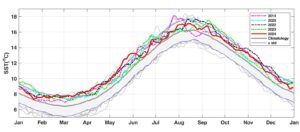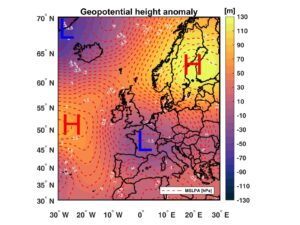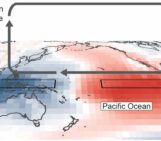
As scientists, we are acutely aware that our planet’s climate is changing, but the speed and severity of these changes can still surprise us. As global temperatures rise, certain regions become hotspots experiencing more intense and amplified warming. As a postdoctoral researcher at the University of Liège, I have been closely studying amplified warming and marine heatwaves in the North Sea under a warming climate and their impacts. The North Sea is a vital and relatively shallow shelf sea in Northwest Europe. In our recent publication in Ocean Science, my colleagues and I revealed that the North Sea is warming at an alarming and accelerating rate, leading to more frequent and intense marine heatwaves (MHW).
From Gradual Shift to Accelerated Warming
For decades, scientists have monitored the gradual yet steady rise in sea surface temperature (SST) in the world’s oceans, a direct consequence of increasing greenhouse gas (GHG) concentrations. However, our recent study of the North Sea, spanning over four decades (1982–2024), reveals a critical and rapid change.
The North Sea appears to have entered a new thermal regime around 2013. Before this shift, the long-term warming trend was significant but manageable, averaging about 0.4 °C per decade. Since 2013, that trend has doubled to 0.8 °C per decade. This accelerated warming is the core issue, as it changes the baseline temperature against which all other fluctuations are measured.
Over the entire study period (1982–2024), 80 MHW events and 1,121 MHW days were recorded, with 55% of these events occurring after the 2013 climate shift. Notably, 26 MHW events were concentrated in five particularly active MHW years: 2014, 2020, 2022, 2023, and 2024.
The Main Driver: Long-Term Warming

The regionally averaged daily sea surface temperature for each year from 1982 to 2024 is shown by gray lines, while the most active MHW years (2014, 2020, 2022, 2023, and 2024) are shown in colored lines. The solid blue lines indicate the ± standard deviation of daily sea surface temperature.
To understand the full picture, we must distinguish between long-term climate change and natural variability that occurs from year to year or decade to decade. This distinction is especially critical when examining Marine Heatwaves (MHWs).
A Marine Heatwave is defined as a period of at least five consecutive days when the sea surface temperature is in the top 10% of temperatures recorded for that specific time of year. Think of it as the ocean having a fever.
Our analysis shows that MHWs in the North Sea have become significantly longer and more frequent over the study period. But what is responsible for this increase?
By carefully removing the influence of the long-term Sea Surface Temperature trend from the data, we were able to isolate the causes. The results were clear: the overwhelming majority—80% of the observed increase in Marine Heatwave frequency– is directly attributed to the long-term, mean warming of the sea.
In essence, climate change is making the North Sea so warm that periods of unusual heat are becoming the new normal. The extreme events we are now seeing are primarily an escalation driven by a higher average temperature, not just random weather fluctuations.
The Role of Atmospheric Patterns

The geopotential height anomalies at 500 hPa during the spring 2024 marine heatwave (10 May–5 June 2024). The dashed contour lines indicate the anomalies in mean sea level pressure (hPa).
The study also highlights how large-scale atmospheric and oceanic circulation patterns – such as the Atlantic Multidecadal Oscillation (a long-term variation in North Atlantic sea surface temperatures) and the East Atlantic Pattern (a large-scale atmospheric pressure pattern) – modulate sea surface temperatures on decadal scales. These patterns can either amplify or dampen the effects of global warming, influencing the timing and severity of marine heatwaves.
For example, the record-breaking marine heatwave in May 2024 was linked to an unusual anticyclonic weather system over the Baltic Sea and southern Norway. This system reduced cloud cover and increased solar radiation, further heating the sea surface.
Ecological Impacts: Shifting Productivity
The consequences of more frequent and intense marine heatwaves are profound for the North Sea ecosystem, an area already under considerable pressure from fishing and pollution.
One critical impact is on chlorophyll concentration, a key indicator of phytoplankton biomass, the foundation of the marine food web. The response to heat stress is not uniform across the region:
- Northern North Sea (deep, cold water): We observed a decrease in chlorophyll concentration. In these naturally cooler areas, excess heat likely exacerbates thermal stress for cold-water-adapted organisms, leading to reduced productivity.
- Southern North Sea (shallow, warm water): Conversely, in these shallow, warmer coastal regions, we found an increase in chlorophyll concentration. This may be due to changes in stratification (layering of water masses) or changes in nutrient availability triggered by warming events.
These opposing responses highlight how marine heatwaves can alter the balance of primary production, creating winners and losers in the ecosystem. Species living near the edge of their thermal tolerance, such as certain zooplankton species (small animals that eat phytoplankton), face physiological stress, which can lead to population collapse and subsequent disruption up the food chain, ultimately affecting fisheries and biodiversity.
The Way Forward
The message from the North Sea is clear: the effects of climate change are not gradual everywhere. In some regions, they are accelerating, leading to a rapid intensification of extreme events such as marine heatwaves. Understanding that 80% of the increase in marine heatwave frequency is embedded in the long-term warming trend provides crucial evidence for policymakers: to mitigate the growing threat of marine heatwaves, we must address the root cause – long-term sea surface temperature rise driven by human-emitted greenhouse gases. For the scientific community, this highlights the urgent need to monitor and model these regional amplifications to better predict and manage the cascading impacts on marine life and the coastal communities that depend on it.
To dive deeper into the research, you can read the full open-access article here.
This post has been edited by the editorial board.
References Mohamed, B., Barth, A., Van der Zande, D., and Alvera-Azcárate, A. (2025): Amplified warming and marine heatwaves in the North Sea under a warming climate and their impacts, Ocean Science, 21, 2505–2525, https://doi.org/10.5194/OS-21-2505-2025




